Numerical Study of Air Distribution and Evolution Characteristics in Airliner Cabin
Abstract
:1. Introduction
2. Numerical Model and Method
2.1. Numerical Model
2.2. Hybrid Thermal Lattice Boltzmann Method for Predicting Cabin Heat Transfer Characteristics
- (1)
- CFL condition limitation:
- (2)
- Restriction condition of the diffusion term:
2.3. Numerical Simulations for Validation
3. Numerical Results and Discussion
3.1. Distribution Characteristics of Airflow Organization
3.2. Evolution Characteristics of Airflow Organization
4. Conclusions
Author Contributions
Funding
Data Availability Statement
Acknowledgments
Conflicts of Interest
References
- Brent, A.; Settles, G.S. A Computational and Experimental Investigation of the Human Thermal Plume. J. Fluids Eng. Trans. ASME 2006, 128, 1251–1258. [Google Scholar]
- Li, M.X.; Zhao, B.; Tu, J.Y.; Yan, Y.H. Study on the carbon dioxide lockup phenomenon in airliner cabin by computational fluid dynamics. Build. Simul. 2015, 8, 431–441. [Google Scholar] [CrossRef]
- Bosbach, J.; Heider, A.; Dehne, T. Flight Testing of Alternative Ventilation Systems for Airliner Cabins. In New Results in Numerical and Experimental Fluid Mechanics IX; Springer International Publishing: Berlin/Heidelberg, Germany, 2014; Volume 28, pp. 275–283. [Google Scholar]
- Bosbach, J.; Heider, A.; Dehne, T. Evaluation of cabin displacement ventilation under flight conditions. In Proceedings of the 28th Congress of the International Council of the Aeronautical Sciences in ICAS2012, Paper 304. Brisbane, Australia, 23–28 September 2012. [Google Scholar]
- Kühn, M.; Bosbach, J.; Wanger, C. Experimental parametric study of forced and mixed convection in a passenger airliner cabin mock-up. Build. Environ. 2009, 44, 961–970. [Google Scholar] [CrossRef]
- Cao, X.D.; Liu, J.J.; Pei, J.J.; Zhang, Y.; Li, J.Y.; Zhu, X.L. 2D-PIV measurement of airliner cabin air distribution with a high spatial resolution. Build. Environ. 2014, 82, 9–19. [Google Scholar] [CrossRef]
- Yan, Y.H.; Li, X.D.; Tu, J.Y. Effects of passenger thermal plume on the transport and distribution characteristics of airborne particles in an airliner cabin section. Sci. Technol. Built Environ. 2016, 22, 153–163. [Google Scholar] [CrossRef]
- Singh, A.; Mohammad, H.; Hosi, R.H. Numerical simulation of airflow in an airliner cabin section. ASHRAE Trans. 2002, 108, 1005–1013. [Google Scholar]
- Baker, A.; Ericson, S.; Orzechowski, J. Airliner Passenger Cabin ECS-117 Generated Ventilation Velocity and Mass Transport CFD Simulation: Velocity Field Validation. J. IEST 2006, 49, 51–83. [Google Scholar] [CrossRef]
- Li, J.Y.; Cao, X.D.; Liu, J.J.; Wang, C.C. Global airflow field distribution in a cabin mock-up measured via large-scale 2D-PIV. Build. Environ. 2015, 93, 234–244. [Google Scholar] [CrossRef]
- Liu, W.; Wen, J.Z.; Chao, J.Y.; Yin, W.Y. Accurate and high-resolution boundary conditions and flow fields in the first-class cabin of an MD-82 commercial airliner. Atmos. Environ. 2012, 56, 33–44. [Google Scholar] [CrossRef]
- Zhang, Z.; Chen, X.; Mazumdar, S.; Zhang, T.F. Experimental and numerical investigation of airflow and contaminant transport in an airliner cabin mockup. Build. Environ. 2009, 44, 85–94. [Google Scholar] [CrossRef] [Green Version]
- Liu, Y.L.; Liu, Z.X.; Luo, J.S. Numerical Investigation of the Unsteady Thermal Plume around Human Body in Closed Space. Procedia Eng. 2015, 121, 1919–1926. [Google Scholar] [CrossRef] [Green Version]
- Li, J.Y.; Liu, J.J.; Wang, C.C.; Jiang, N. PIV methods for quantifying human thermal plumes in a cabin environment without ventilation. J. Vis. 2017, 20, 535–548. [Google Scholar] [CrossRef]
- Wang, C.C.; Liu, J.J.; Li, J.Y.; Li, F. Chaotic behavior of human thermal plumes in an airliner cabin mockup. Int. J. Heat Mass Transf. 2018, 119, 223–235. [Google Scholar] [CrossRef]
- Yang, C.; Liu, J.; He, F. Evolution of large-scale flow structures and traces of marked fluid particles within a single-aisle cabin mock-up. Build Simul. 2017, 10, 723–736. [Google Scholar] [CrossRef] [PubMed]
- Zhao, Y.; Liu, Z.; Li, X.; Zhao, M.; Liu, Y. A modified turbulence model for simulating airflow aircraft cabin environment with mixed convection. Build Simul. 2020, 13, 665–675. [Google Scholar] [CrossRef] [PubMed] [Green Version]
- ASHRAE. Standard 161–2018; Air Quality within Commercial Aircraft. Atlanta, American Society of Heating, Refrigerating and Air-Conditioning Engineers, Inc.: Atlanta, GA, USA, 2017. [Google Scholar]
- Fiala, D.; Lomas, K.J.; Stohrer, M. Computer prediction of human thermoregulatory and temperature responses to a wide range of environmental conditions. Int. J. Biometeorol. 2001, 45, 143–159. [Google Scholar] [CrossRef]
- Chen, Y.S.; Shan, X.W.; Chen, H.D. New direction of computation fluid dynamics and its applications in industry. Sci. China Ser. E Technol. Sci. 2007, 37, 1107–1116. (In Chinese) [Google Scholar]
- Wang, X.; Shangguan, Y.Q.; Zhang, H.; Li, Y.M. Numerical study on the near-wall characteristics of compound angled film cooling based on hybrid thermal lattice Boltzmann method. Appl. Therm. Eng. 2018, 129, 1670–1681. [Google Scholar] [CrossRef]
- Wang, X.; Aoki, T. Multi-GPU performance of incompressible flow computation by lattice Boltzmann method on GPU cluster. Parallel Comput. 2011, 37, 521–535. [Google Scholar]
- Shangguan, Y.; Wang, X.; Li, Y. Investigation on the mixing mechanism of single-jet film cooling with various blowing ratios based on hybrid thermal lattice Boltzmann method. Int. J. Heat Mass Transf. 2016, 97, 880–890. [Google Scholar] [CrossRef]
- Buick, J.M.; Greated, C.A. Gravity in a lattice Boltzmann model. Phys. Rev. E 2000, 61, 5307–5320. [Google Scholar] [CrossRef] [PubMed] [Green Version]
- Hou, S.; Sterling, J.; Chen, S.; Doolen, G.D. A lattice Boltzmann subgrid model for high Reynolds number flows. Fields Inst. Commun. 1994, 6, 151–168. [Google Scholar]
- Chen, F.; Yu, S.C.M.; Lai, A.C.K. Modeling particle distribution and deposition in indoor environments with a new drift–flux model. Atmos. Environ. 2006, 40, 357–367. [Google Scholar] [CrossRef]
- Xiao, G.M.; Zhang, C.; Gui, Y.W.; Du, Y.X.; Liu, L.; Wei, D. TLBM-FVM cross-scale method for thermal environment prediction of airliner cabin. Acta Aeronaut. Astronaut. Sin. 2021, 42, 625710. (In Chinese) [Google Scholar]
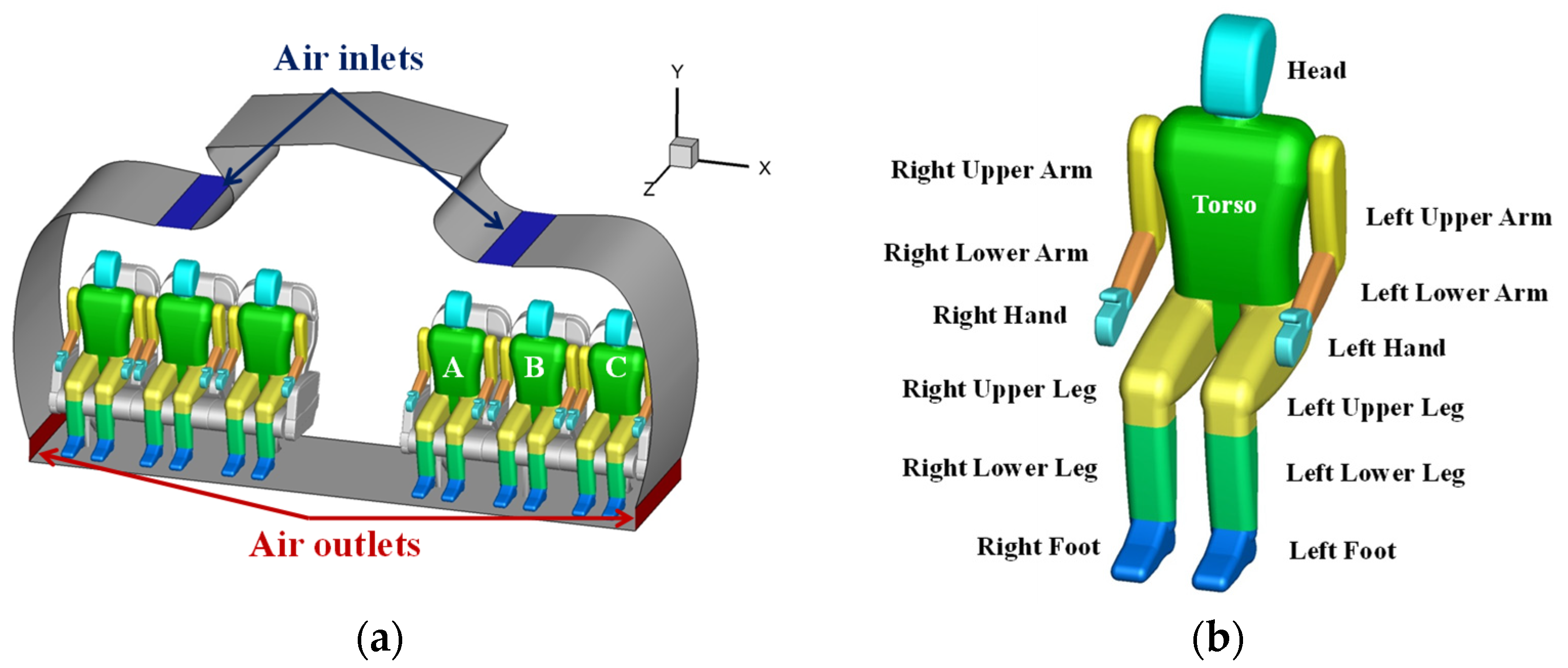


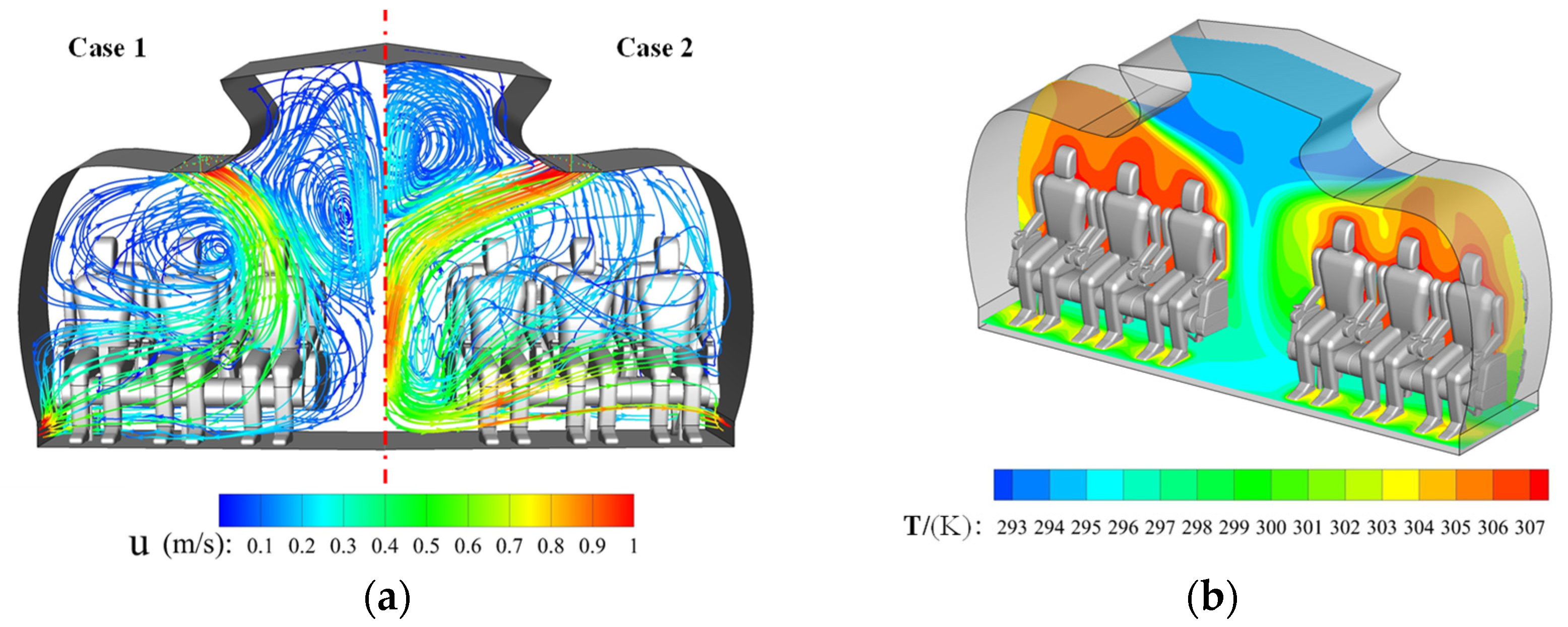
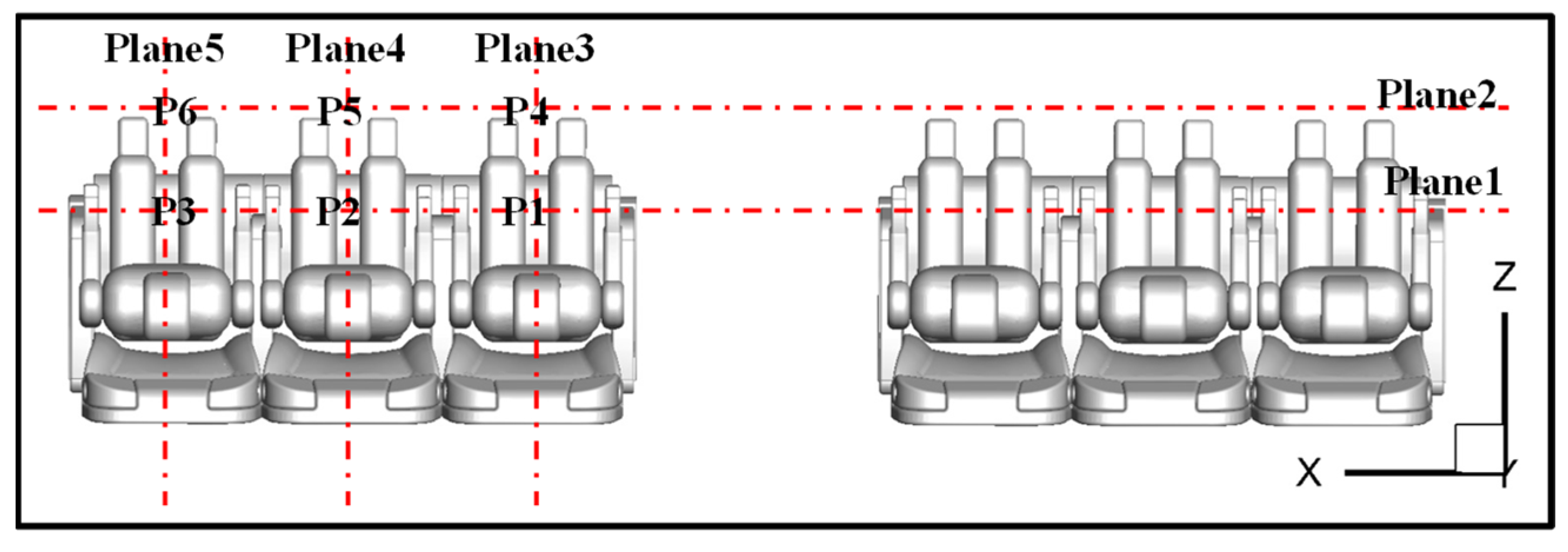
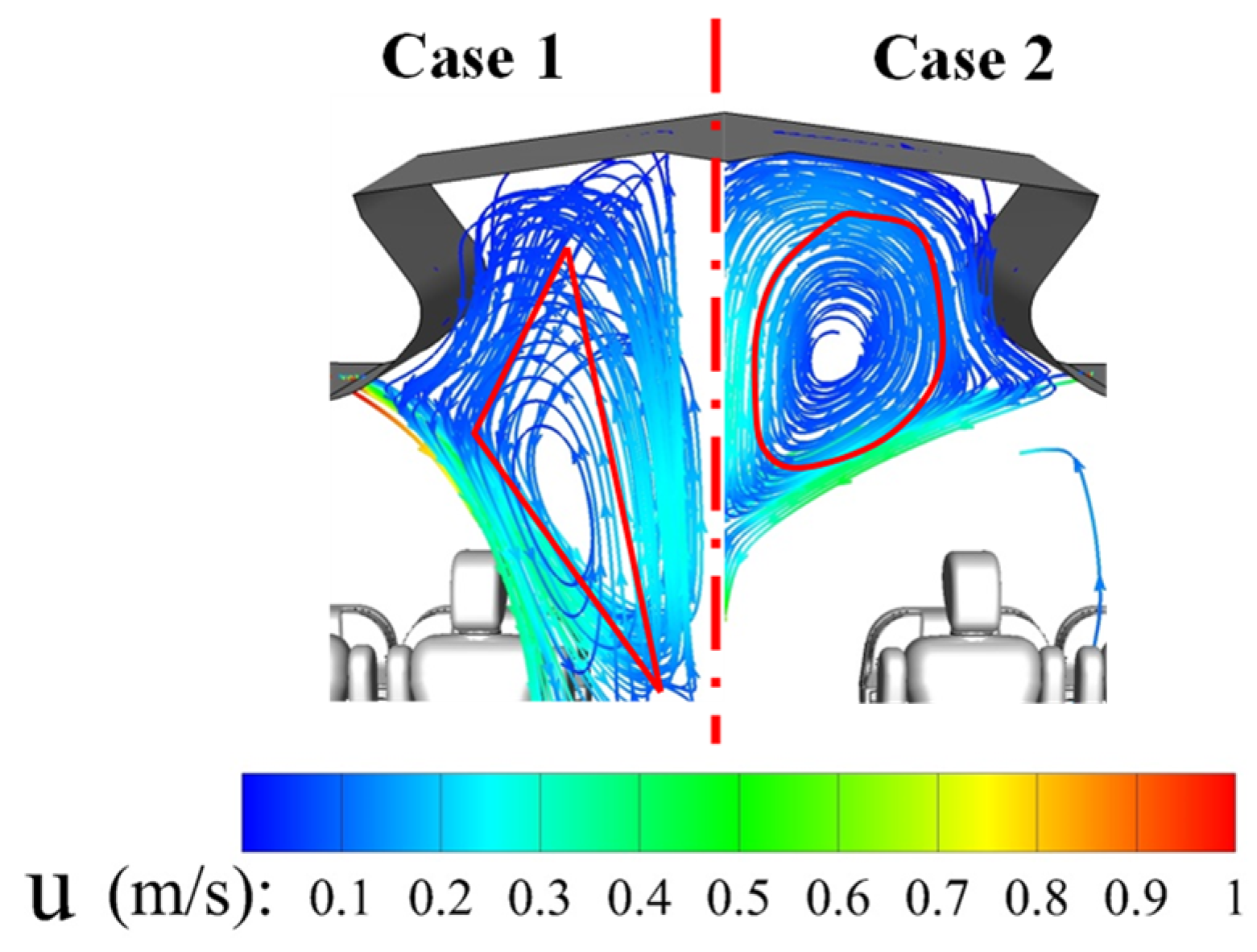
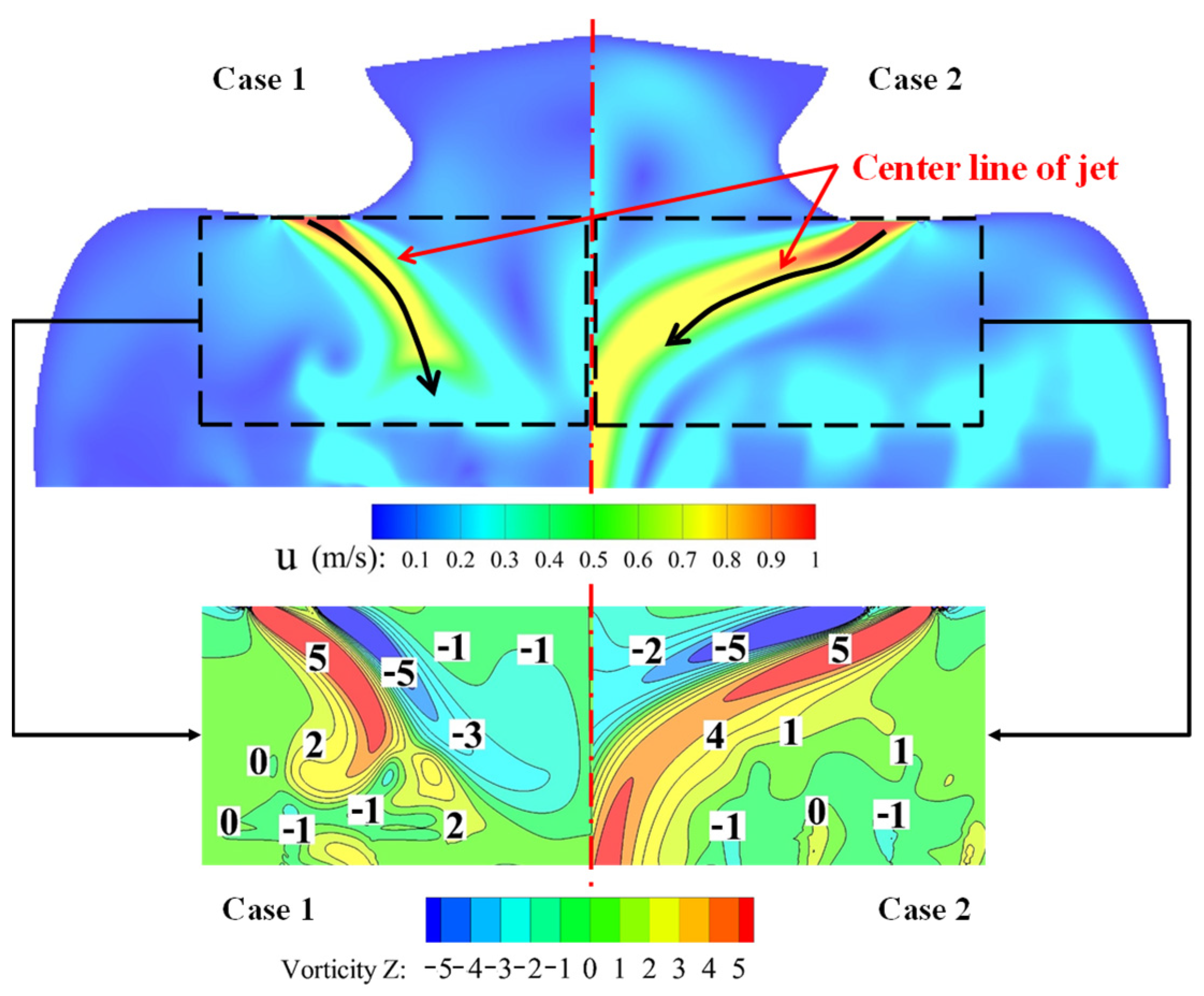
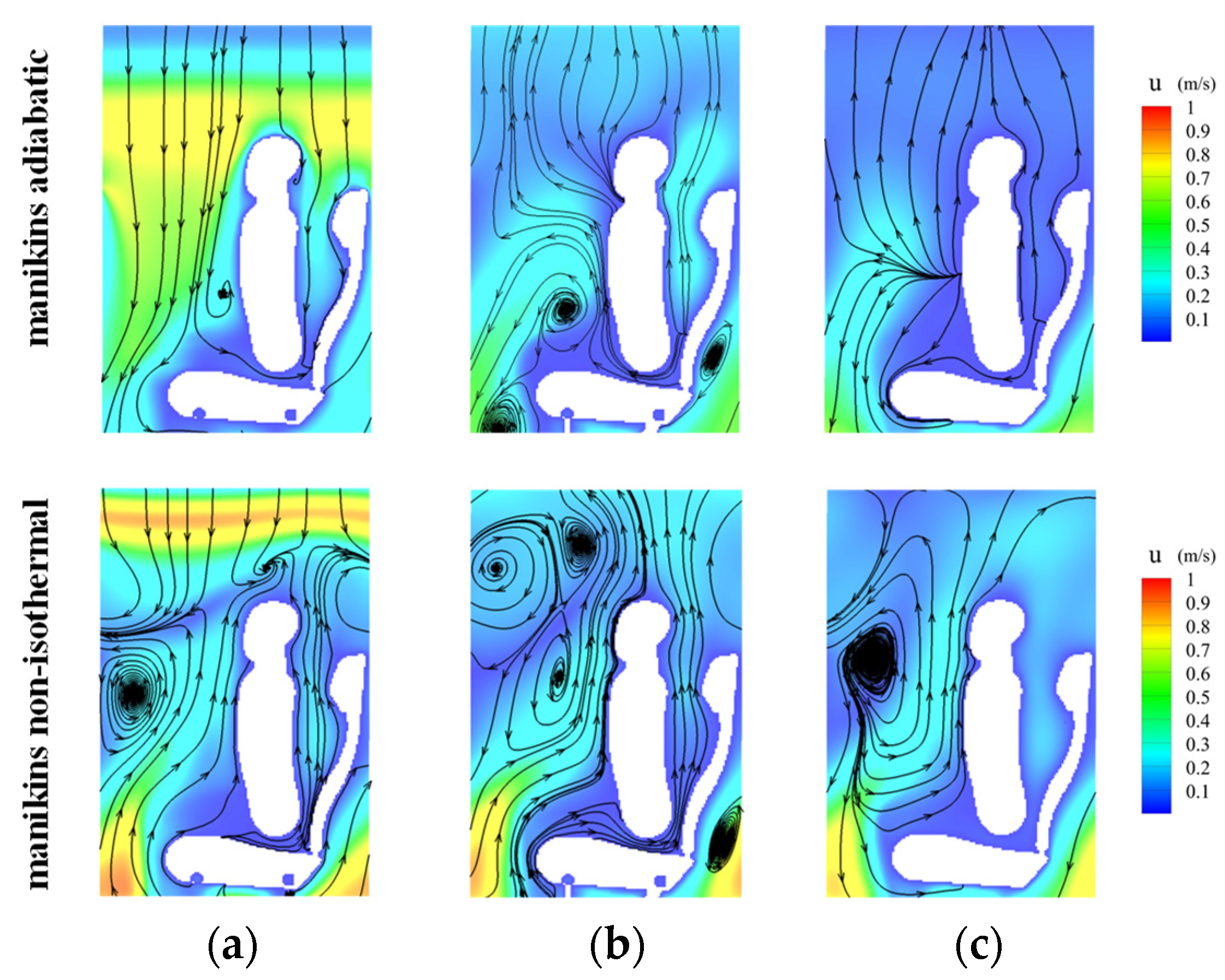

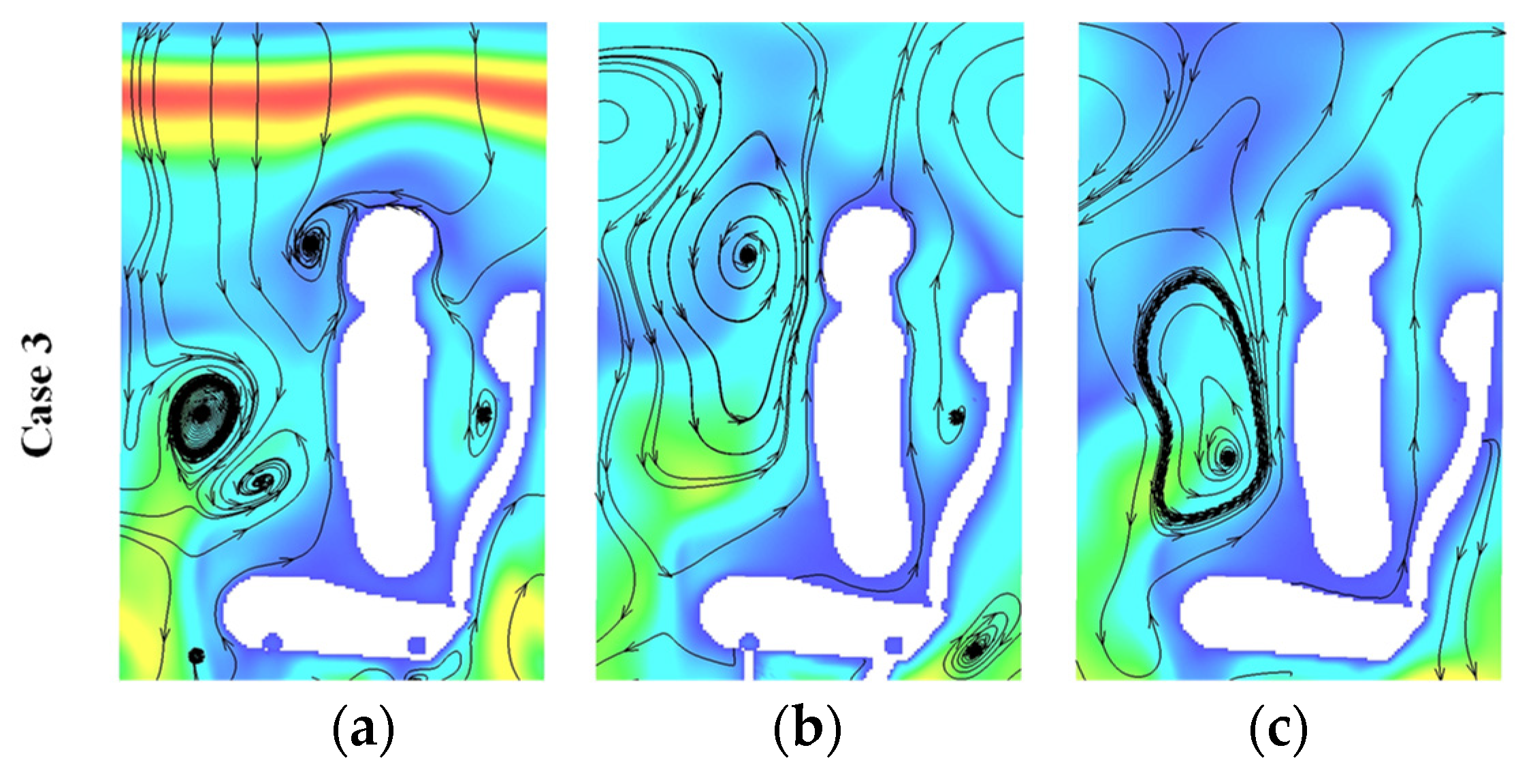
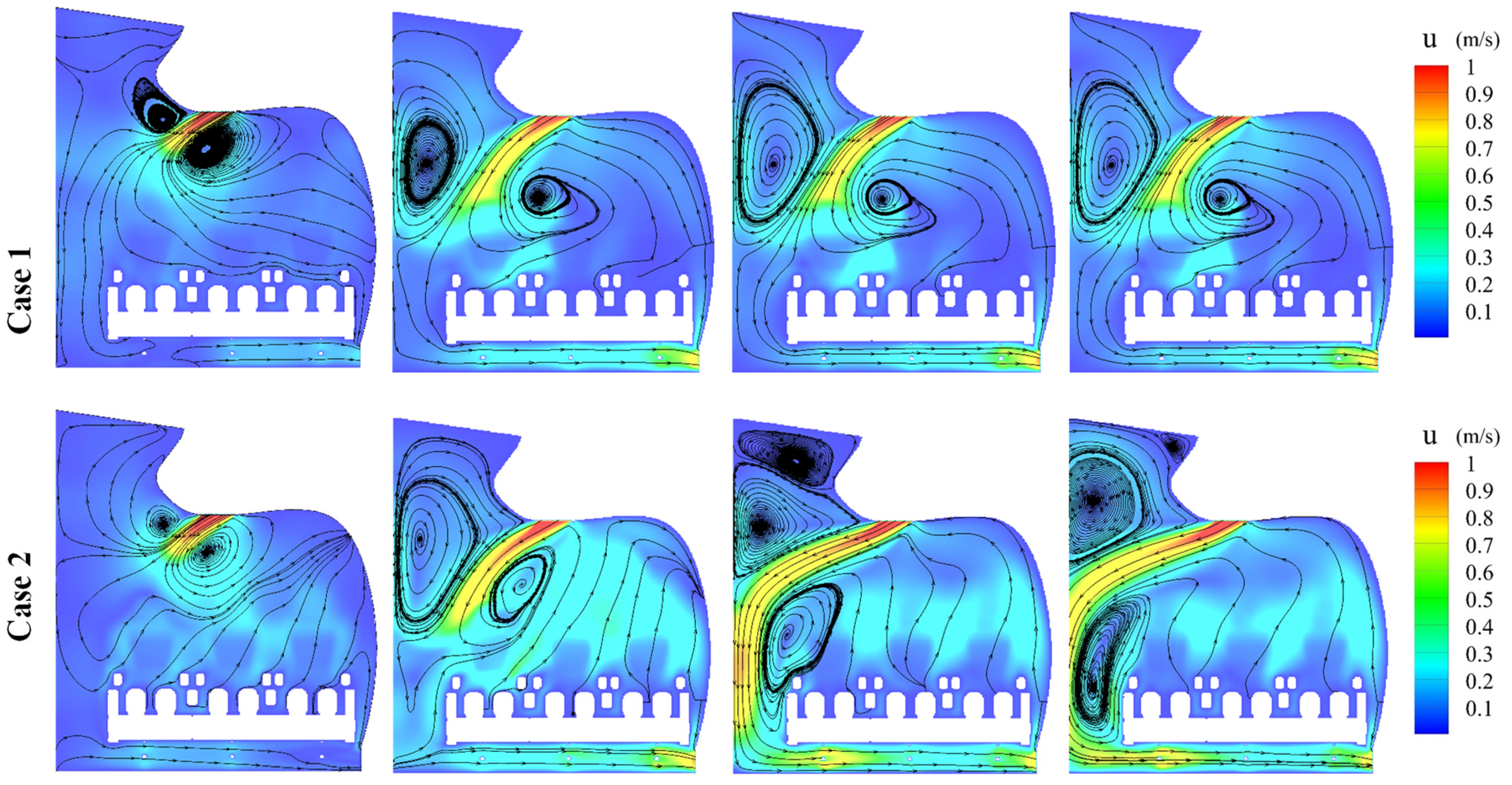

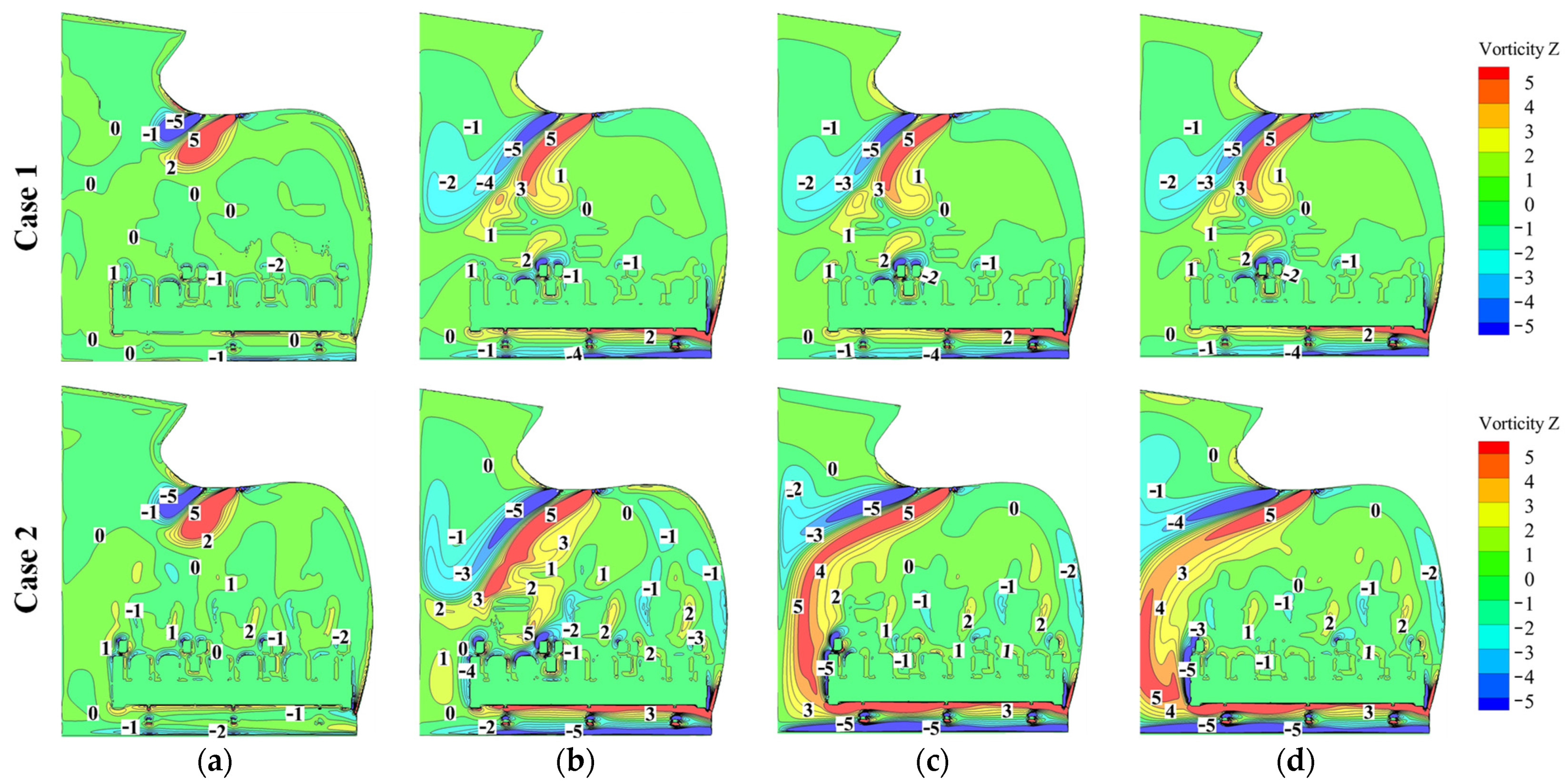
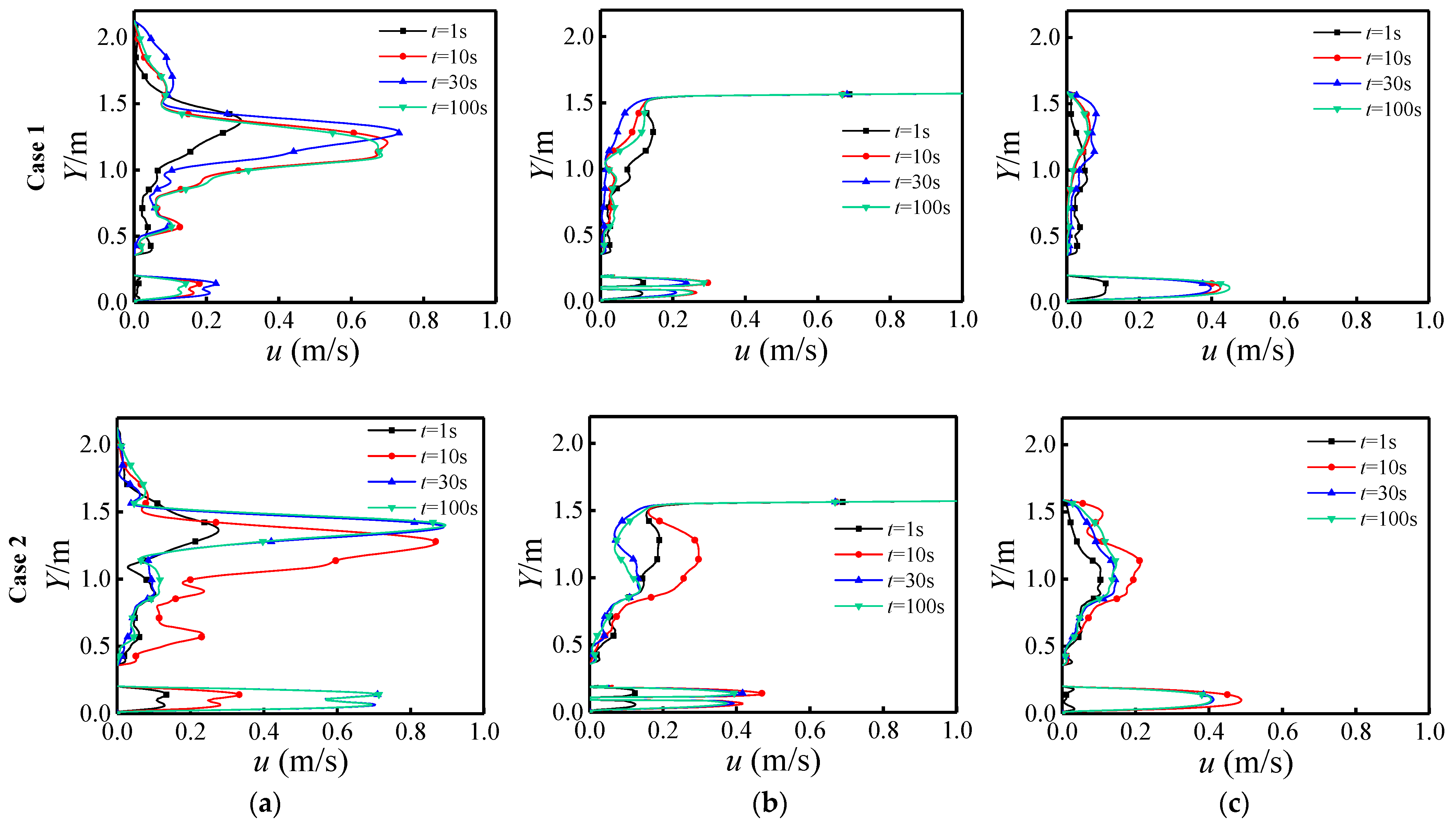
| Boundary Type: Air Inlets | Aircraft Cabin | ||
|---|---|---|---|
| Air-Velocity (m/s) | Inlets | 1 | |
| Air-Angle (°) | 45 | ||
| Air-Temperature (°C) | 20.0 | ||
| Boundary Type: Wall | Aircraft Cabin | ||
| Temperature (°C) | Chair | Adiabatic wall | |
| Wall | Adiabatic wall | ||
| Manikins | Head | 34.2 | |
| Torso | 34.3 | ||
| Upper Arm | 33.5 | ||
| Lower Arm | 32.7 | ||
| Hand | 33.5 | ||
| Upper Leg | 33.7 | ||
| Lower Leg | 32.6 | ||
| Foot | 32.2 | ||
Publisher’s Note: MDPI stays neutral with regard to jurisdictional claims in published maps and institutional affiliations. |
© 2022 by the authors. Licensee MDPI, Basel, Switzerland. This article is an open access article distributed under the terms and conditions of the Creative Commons Attribution (CC BY) license (https://creativecommons.org/licenses/by/4.0/).
Share and Cite
Yu, Z.; Xiao, G.; Zhang, C.; Gui, Y.; Du, Y. Numerical Study of Air Distribution and Evolution Characteristics in Airliner Cabin. Processes 2022, 10, 2621. https://doi.org/10.3390/pr10122621
Yu Z, Xiao G, Zhang C, Gui Y, Du Y. Numerical Study of Air Distribution and Evolution Characteristics in Airliner Cabin. Processes. 2022; 10(12):2621. https://doi.org/10.3390/pr10122621
Chicago/Turabian StyleYu, Zhonghao, Guangming Xiao, Chao Zhang, Yewei Gui, and Yanxia Du. 2022. "Numerical Study of Air Distribution and Evolution Characteristics in Airliner Cabin" Processes 10, no. 12: 2621. https://doi.org/10.3390/pr10122621






